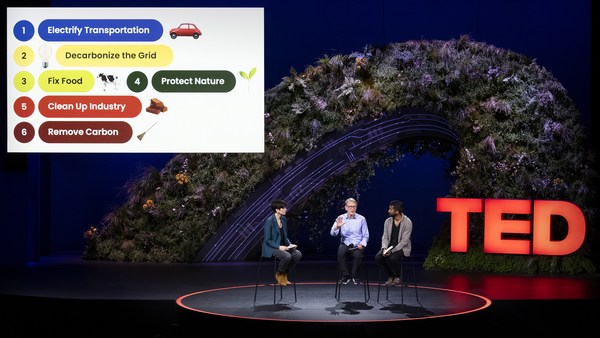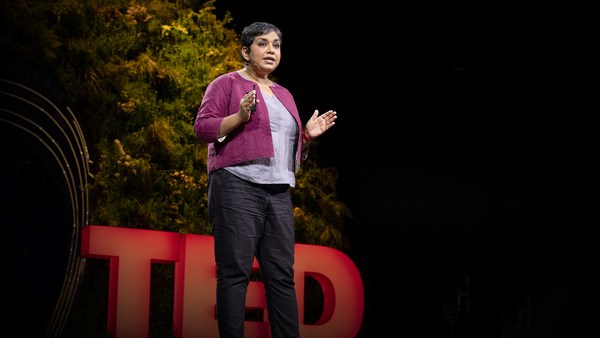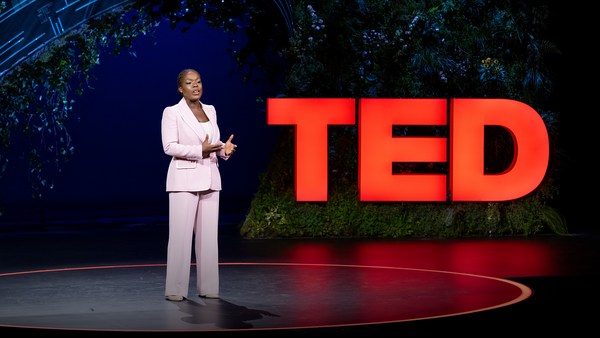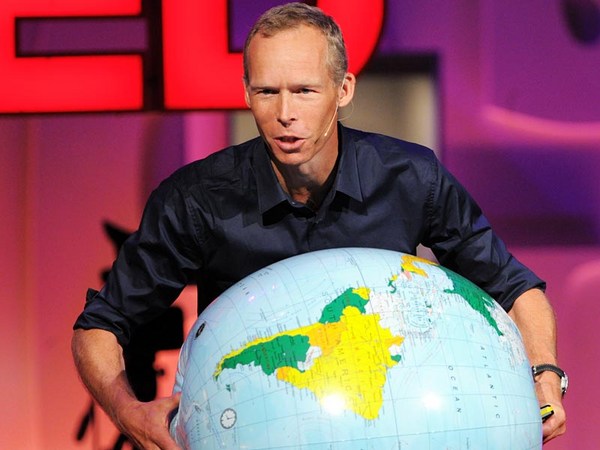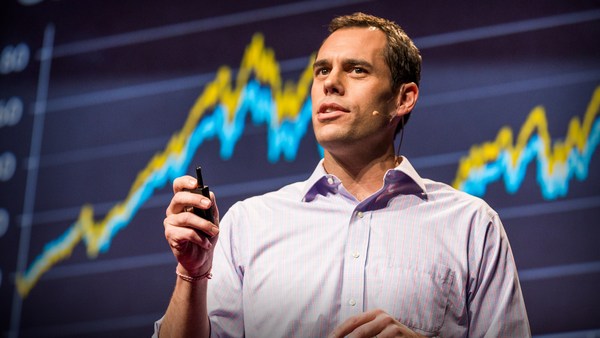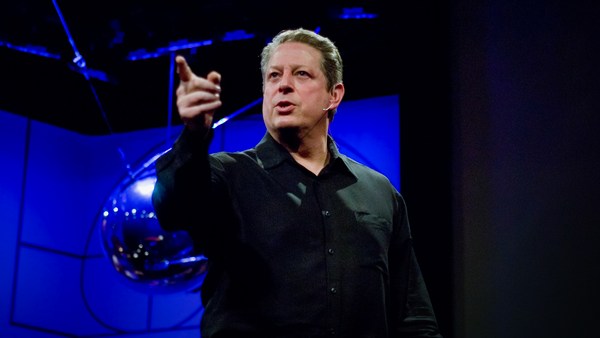Thirteen years ago, I was living in Washington, DC. I was working with the Department of Energy to identify breakthrough technologies to help solve climate change. And I remember one particular day, sitting in a windowless room, in massive concrete buildings, and talking with colleagues about how this particular wind technology, or solar, or battery technology could solve climate, if only we had enough resources.
And then, I met my mentor, Maurice Kaya. And he had a very different perspective. He lived 5,000 miles away, in Hawaii, and he'd been working on the ground, implementing clean energy technology with communities. He'd been doing it for more than 30 years. And he asked me, "What if we brought this decision-making on breakthrough technologies closer to the ground, closer to people who are actually being affected by new technologies. What would that unlock? What would that look like?" And he invited me to move to Hawaii to figure out just that.
And so I did, I moved to Hawaii. And all of a sudden, it wasn't just my job to identify interesting new technologies from DC, but to actually wrestle with some of the challenges on the ground. I was right in the thick of it. This was 2009. Electricity prices in Hawaii were three times those in other states, and people couldn't afford to pay their bills. At the same time, solar energy, electric vehicles, were just starting to come into their own, and it was actually cheaper to use these than burn oil.
So Hawaii presented this perfect opportunity to demonstrate how to transition an entire economy off of fossil fuels. It was all getting real. The battery that we’d written a check for, in DC, was now on a ship on its way to Hawaii, ready to be installed just a few miles from my home. And so Maurice and I, seeing this transition was happening, and the fact that we needed many new technologies in order to make it work, started a nonprofit called Elemental, an investment platform. We've now invested in over 100 start-ups, and we've funded more than 70 projects that are first-of-their-kind technology projects to actually implement these technologies on the ground, in communities. And we’re testing this thesis: Can we actually make better investment decisions if we're closer to communities and the places where we're implementing these new ideas?
And what we've learned in the last dozen years is that, yes, while technology brings half the solution, the community brings the other half. But there is a huge gap in the amount we're investing in the technology to reach this transition and the amount we're investing in the communities and the community capacity and infrastructure to actually deploy these technologies at scale.
Last year, globally, about 500 billion dollars was invested in the technology side of the decarbonization equation. And while this is really necessary and needed -- and in fact, it needs to increase four to 10 times in order to get where we need to go in emissions -- we're not keeping up on the community side, and the gap is only growing. Last year, nonprofits working on community-based climate solutions received less than nine billion dollars in funding. This gap is widening quickly, and it's putting our ability to deploy new climate solutions at risk.
So let me be more specific. Over the last dozen years, we've tested and experimented with many, many ways to actually try to rebalance this equation, to bring community investment more in line with technology investment. You're probably wondering what we actually mean by community investment. Obviously, [it] looks really different from investing in a start-up. What I mean is investing time, political capital and resources in government, particularly local government, and the ability to permit, plan for, integrate, work with new climate technology that's coming to all these local jurisdictions. And on the community side, what I mean is investing in nonprofits, in education, and in hiring locally so that we actually have the capacity in local places to implement these technologies, and then investing in the bridging between these different sectors. What we found is that investing in this more holistic way, on government, communities and technology, not only increases our impact but also leads to better financial outcomes. The companies that we've worked with in our portfolio have now raised over five billion dollars in follow-on funding, and they're operating in more than 60 countries globally.
I'll give you two examples from the portfolio, one in concrete and one in water. These happen to be the two most abundantly consumed materials on the entire planet. So first, concrete. In 2018, we invested in a start-up that introduces captured carbon dioxide into concrete. And the CO2 is then mineralized in the concrete and stored forever in our bridges and buildings. But inventing this very cool new technology alone wouldn't do that much to solve the climate crisis. Real people have to use it. So in addition to implementing it with architects and concrete operators in Hawaii, on the ground, and the Department of Transportation, in a real highway, we brought in local government, to create demand for this new concrete. So with the start-up and our mayor and our city council, we passed a resolution to prefer low-carbon concrete in all new projects.
Now you may ask, "Well, what does this one specific policy in this specific place have to do with really solving global climate challenges?" Well, a few months after we passed that resolution, our mayor brought this to 200 mayors, who passed the same policy for cities all over the country. So now --
(Applause)
So now, this one project, that stores about 700 tonnes of carbon dioxide in Hawaii, which is about the equivalent of taking 150 cars off the road per year, is scaling to cities around the country, and also around the world.
But this isn't just about investing in the local government capacity that can meet technology and help scale it. It's also about investing in communities. So I'll give you an example from water. Last year, there was a community leader who started a nonprofit to specifically address water pollution and pollution on reefs, beaches and Hawaiian fish ponds, like the one in this picture. They didn't have the technology to figure out how to deal with the polluted water that was coming off all of these different buildings. So we scoured the globe and found a start-up that turns polluted water into clean water and clean electricity, by using methane from the process and reinjecting the facility. See, like in so many cases, the nonprofit and the start-up actually have similar goals. The nonprofit, though, can't really reach its goal of addressing water pollution without technology to address at the source. And the start-up would have a much harder time implementing its technology locally without the local relationships and trust and know-how that the nonprofit brings.
Now I won't pretend that bridging these two is easy, or that working together is easy. Start-ups and grassroots organizations, community organizations, they speak very different languages, and a lot of bridging is required between them. But this is the kind of work we need to do, if we're going to start rebalancing the equation between technology investment and community investment. We, as the investor, often actually pay the nonprofit to do this kind of work. We think this is a key part of the equation: paying the nonprofit for their expertise, just as you would pay an electrical contractor, a general contractor on a project, for their value.
(Applause)
And really importantly, then, building this kind of financial mechanism into every single project so that, as we’re scaling climate projects that are working, we're also scaling investment in the communities at the same time. In our experience, it's been particularly important in honoring Indigenous communities, bringing them into the cocreation process early, rather than asking for free advice. Now we, as investors, often pay the nonprofit partners and ourselves, and we also train start-ups to do this so that, as they become big companies, as they scale globally, they're doing this around the world as well. And this isn't happening nearly enough, but it's one tool we can use to start rebalancing the equation between community and technology investment.
So these cannot be one-off examples, if we are to meet the challenge of climate change. Globally, we will need 700,000 electric busses, 25 million solar panels, 400 million vehicle chargers, to meet this challenge. Just imagine all of the decisions that need to be made, all the physical things that need to be installed in real places. Global climate progress relies on local action.
And this truly is where it gets really hard. It's actually relatively easy to invest from a windowless room and not really think about all the consequences of implementation on the ground, as I did when living in DC. It's much harder for us and me to walk into an unfamiliar situation and acknowledge that we really don't have all the answers.
I remember early in this work, bringing a new transportation app to parents who'd said that transportation access was one of their key challenges. We were in this beautiful space, open-air -- didn't even need to open the windows, all fresh air. I was demonstrating this new app to them, and saying, "Do you think this would help you? What's your feedback? Do you think you would use this?" And they looked at me kind of perplexed, and said, “Well, this is a sort of an interesting, fancy new app, but we wouldn't use this. What we really want is our after-school shuttle back, that was cut from the city budget last year." And I was turning red, and I could feel the heat rising in my face. I mean, talk about uncomfortable. But it's conversations like these that have changed completely the way that we invest in start-ups. Yes, we do technical due diligence and financial due diligence. But can we be better investors by actually asking the communities, which we ask every time now, before making an investment decision, "Would you use this? Is this something that you actually want?"
It's what Maurice taught me, early on. You need to get out of the office, get on the ground and listen to what people really need.
Technology can only bring half the solution. The community brings the other half. And we have to fix this imbalance now if we want to fix climate change, and we do. For any of these new solutions to work for climate, they have to have at least these two ingredients: the technology that scales and the relationships and empathy that we share. This is what we'll need to create a future where our children can thrive. And I have a particularly large stake in that.
(Laughter)
Thank you.
(Cheers and applause)
